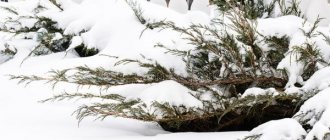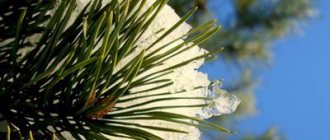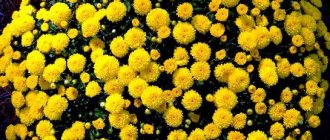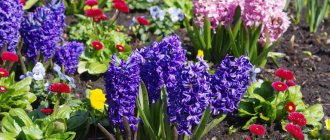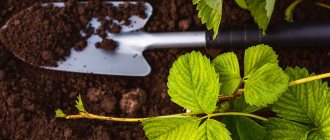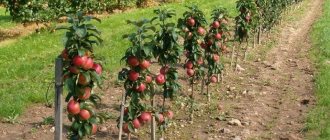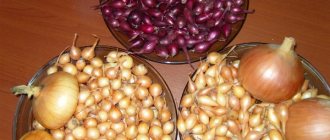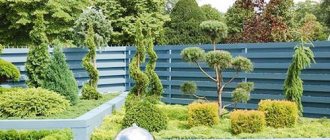Coniferous plants are decorative and easy to care for. At the very least, spruce, pine or juniper, due to their unpretentiousness, are considered residents of the “lazy” garden. Therefore, if you are planning to buy coniferous trees, then this is an excellent solution for quickly greening your landscape. And coniferous trees and bushes can almost immediately after planting become a real decoration of your garden, especially if you plant an adult plant. But young conifers are also very suitable for express gardening. In addition, decorative conifers can be planted even in winter! But they have one peculiarity. Mistakes made during relocation make themselves felt only 3-6 months after the autumn transplant, or 1-2 months after the spring transplant. Therefore, the process of planting conifers in the garden is extremely important. To make sure it goes as it should, read this article.
Features of spring transplantation
When to plant conifers in the garden in spring? The question is very important, because the calendar spring consists of three whole months with very different weather conditions. Spring planting of coniferous trees and bushes should be done as soon as the ground has melted enough to allow it to be done. That is, in early, early spring, almost immediately after the first thaw.
Young coniferous roots begin to grow at a soil temperature of + 3 degrees. And they are not afraid of possible frosts. If you did not have time to replant before the active growth of the aboveground part of coniferous plants began, it is better to wait until the fall.
Important! During the period of bud growth, decorative conifers cannot be replanted!
When is a transplant needed for conifers?
In addition to the initial planting, spiny pets sometimes have to be replanted. A common reason is that the planting is too dense initially. Representatives of conifers, like most plants, grow over time and can begin to interfere with each other. In this case, a transplant is needed.
It happens that a tree or shrub grows and begins to spoil the entire composition (for example, an oversized specimen on an alpine hill). In this case, the plant is also replaced.
As a result of any errors in the culture, the trees may begin to get sick and die; if this is noticed in the early stages, then replanting can also help.
Time for transplantation, features of autumn, spring and summer planting
For the successful development of conifers, the timing of planting is very important, because such procedures are a great stress for the plants. It is almost impossible not to damage the root system, and it is a weak point in evergreen crops. It is ideal to plant when the tree or shrub is either dormant or preparing to emerge. Therefore, most often such operations are performed in the fall or spring.
Spring planting is suitable for most conifers. It is carried out as soon as the ground has thawed, but always before young needles appear - in this case the plant has a good chance of taking root. The advantages of spring planting include the fact that by the beginning of winter, the new resident of the garden will have developed a sufficient number of roots. In the first year after planting, special attention should be paid to the watering regime of the plantings.
What conifers can be planted in summer
In summer, coniferous plants can be planted, but only those that have a closed root system, that is, sold in pots. But there is one unpleasant moment here that can nullify all good intentions.
The fact is that, as a rule, we cannot be completely sure whether the seller transplanted a coniferous plant into a pot from open ground before selling it to us as a container crop.
If such a phenomenon occurred, there is practically no chance that the conifer transplanted in the summer will take root in the new place. Even if the plant looks healthy when you buy it, you will create very attractive conditions for its growth.
That is why experienced gardeners do not recommend planting container conifers purchased from unverified sellers in the summer. Such plants have a better chance if planted in spring or autumn.
Planting and replanting conifers in autumn
November is a sad time in the garden. All the leaves have fallen off, the flowers have faded. And only coniferous plants delight the eye with their clean, fresh greenery, which looks especially bright against the backdrop of a bare garden. But they also entered a period of peace. And this is just the right time for transplants or new plantings. In recent years, winters in the Moscow region have been delayed until the end of December, or even January, and even in November there are still fine days when you can finally pay attention to conifers.
Recommended for you:
Many experts and experienced gardeners advise replanting and replanting coniferous plants either in the spring or at the end of August - September.
But during this period there is such a jam in the vegetable garden and flower beds that there is simply no time left. But, I can say with confidence, my experiments in planting and replanting conifers in November turned out to be quite successful - there were no plant losses; on the contrary, they all took root well. Since planting material is offered by nurseries exclusively in containers (I have never seen one with an open root system), planting comes down to a simple transfer of conifers, during which the root system is not injured. When replanting, I also try to dig up the plant with a lump of earth and transfer it to a new place.
Why else do I prefer this time to transplant conifers? When we create a composition of compact coniferous plants, it is difficult to predict how one or another of them will grow and develop. And now some are starting to literally “hammer” their neighbors, and no amount of pruning can correct the situation. During the growing season, we see this, and we want to correct mistakes immediately, without delaying until spring, when we again don’t get around to it and forget what should have been done. This happened to me with the creeping Kazatsky juniper, which turned out to be a very fast-growing plant and covered all the crops around it with its branches. He transplanted and tied the lashes, pointing them upward. Now it grows in a bowl shape. It looks unusual, but you will have to cover it for the winter, as heavy wet snow can break off the branches.
Autumn planting of conifers
Gardeners' advice on when is the best time to plant conifers in the fall is divided into two camps:
Some believe that it is better to plant conifers in the fall at the end of August - beginning of September, when the roots of the plant are actively growing. This ensures its success.
Others argue that the best time for autumn replanting of ornamental coniferous trees and bushes is when they have just entered winter hibernation. In our climatic conditions, this is usually November.
Important! During the period when the plant is preparing for winter hibernation (up to three weeks), it cannot be replanted. At this time, complex chemical processes occur in it, which should not be interfered with.
Features of autumn, spring and summer planting of coniferous plants
In the process of landscaping a site, conifers are increasingly being used, because they have many advantages: controlled growth, lively appearance at any time of the year, relative unpretentiousness, variety of shapes and sizes. They are used to create various landscape compositions, planted as solo plants or as a background for other representatives of the flora... Sooner or later questions arise about how to properly plant and when to replant coniferous plants, since most of the success depends on these moments.
Features of winter transplantation of conifers
In winter, you can replant any conifers. Winter, oddly enough, is the ideal period for this. But it is better to plant large adult plants only in winter! In general, “aged” decorative conifers are considered very capricious when transplanting. But the survival rate in new conditions during winter transplantation is close to 100%.
Key words: When to plant coniferous plants, Planting conditions, Time of year, transplantation, l, thuja, juniper, pine, cedar, winter, summer, autumn, spring, planting rules, when to plant, temperature, earth, soil, buy coniferous trees, Ornamental plants, Catalog, plant nursery, Kiev
The best time to transplant coniferous plants
Trees are transplanted in autumn or early spring. During these periods, plants are in a stage of reduced sap flow. The likelihood of plants getting stressed is minimal, adaptation is more successful and the risk of death of a bush or tree is reduced.
Autumn replanting is carried out at the end of October or at the beginning of November, when relatively warm days (without frost) can be found. The favorable period is from the beginning of leaf fall to the first frost. At subzero temperatures, there is a high risk of freezing of the root system. It is necessary to insulate the root and soil along the radius of the intended rhizome.
It is a common practice to replant conifers in the spring, when the ground has already thawed. You need to be in time before the first new needles appear. The advantage of spring planting is that the root system of the transplanted plant will strengthen over the summer and autumn months. The ephedra will be better prepared for wintering.
Coniferous trees: features of planting and care
Coniferous trees are very popular in landscape design. To get an attractive and healthy plant, you need to know and follow the rules of planting and care, as well as correctly use fertilizers for conifers in spring and autumn. Such plants in adulthood are more difficult to tolerate transplantation than deciduous crops, but young specimens show a fairly high survival rate.
When to replant coniferous trees
Coniferous trees and shrubs can decorate your garden throughout the year. They do not shed their needles for the winter and always remain decorative. Coniferous shrubs look neat on slopes and beautifully decorate the foreground of a composition; ground cover varieties can quickly green up large areas in your garden. Coniferous ornamental trees with a columnar crown are often used to create hedges. Plants with yellow or blue needles act as a beautiful color accent, and trees with a weeping shape can become an interesting tapeworm on the site. You can buy coniferous trees on the website Greensad.ua.
Coniferous trees photo:
How and when to plant and replant in the fall
Soil and climatic conditions in different regions of our country differ significantly, and in order to properly plant conifers on a site, weather factors should be taken into account. Planting can take place in October or November. Preparing plants for winter is a complex chemical process during which the chemical composition of cells is adjusted by reducing the amount of water and increasing the carbohydrate content. After the plant goes into so-called hibernation, it can be safely replanted and planted in a permanent place.
According to the advice of specialists and experienced gardeners, autumn planting of conifers can be carried out in August or September, at the stage of active growth and development of the suction root system. High survival rates are ensured by the ability of the root system of a coniferous plant to quickly regenerate . In any case, it should be remembered that conifers should be planted without violating the integrity of the earthen ball around the root system. In this case, the plant takes root very quickly.
Requirements for planting and transplanting conifers
When seedlings of conifers, you need to plan the placement in advance in order to immediately transplant them to their permanent habitat. It must be taken into account that these trees grow large, with an extensive crown. There should be enough space so that the plants do not interfere with each other. It is not advisable to plant them next to fruit trees. The soil should not be clayey.
Additional drainage will create conditions for favorable rooting and development of conifers. When moving a plant from one place to another, it is important to maintain a ball of earth around the rhizome. It contains specific fungi, without which the life of these flora representatives is impossible. Plus, the roots are protected from mechanical damage.
How and when to plant and replant in spring
Planting blue spruce, juniper, fir and other conifers, which are popular in our country, can be done not only in the fall, after the heat subsides, but also in early spring, even before the onset of very hot weather. The technology and rules for planting coniferous plants are as follows:
- If the site is represented by heavy and clayey soils, then it is necessary to provide the plants with drainage from broken bricks and sand.
- The distance between planted conifers depends on the growth and development of the tree: dwarf varieties should be planted with a distance of 30-35 cm, and tall plants should be planted with a distance of 50-70 cm.
- Most types of coniferous crops grow well on soils that include turf soil, peat, humus and sand in a ratio of 2: 2: 2: 1, with the addition of 0.25 kg of nitrophoska or 0.15 kg of Kemira-universal.
- A good result is achieved by adding about 8-10 kg of sawdust into the planting hole when planting fir seedlings.
- When planting seedlings of yew, pine and Cossack juniper, it is advisable to add lime to the planting hole.
Features of caring for coniferous trees in different regions
In the harsh conditions of the Ural and Siberian regions, coniferous trees are planted using zoned varieties and species:
- cedar pine;
- fir;
- common and gray Siberian spruce;
- Scots pine;
- western thuja.
In order for the conifer to take root, in the conditions of the Urals and Siberia it is planted in the spring, after the snow has melted. Autumn seedlings require serious shelter, but this does not guarantee survival. The time frame for planting and caring for conifers in the Urals and Siberia depends on their harsh continental climate.
Plant feeding is carried out in the spring, after the soil has thawed and frosts have stopped. Unlike the Moscow region, in the eastern regions they do not fertilize the soil under conifers in August so that shoots have time to form. Pruning in western regions is carried out at the end of winter or early spring, and in the Urals and Siberia - in the spring, before buds open and at the end of summer. For successful wintering, the mulching of the tree trunk circle of coniferous trees is made slightly higher than in the Moscow region: up to 20 cm. If the plants are young, short or have dwarf shapes, it is possible to cover them with ties and special covers. Adult zoned conifers successfully overwinter and subsequently do not require special shelter. It is better to transplant large trees in the eastern regions, as in the Moscow region, in winter.
Coniferous trees: planting and care (video)
The area for planting should be prepared depending on the biological characteristics of the crop being planted:
- most varieties of pine and juniper are characterized by light-loving properties, and they are best planted in open and well-lit areas;
- for growing thuja and thuja, you can set aside a place with sufficient lighting and partial shade;
- Fir, spruce, and hemlock should be planted in the presence of sufficient shade, and yew belongs to the category of the most shade-tolerant.
The root collar of the plant must be located at the same level with the soil. For better survival rates, it is recommended to carry out foliar feeding with Epin. A prerequisite for faster adaptation of a plant to a permanent location is abundant watering.
Conifers, planting and replanting in autumn, shelter for the winter
Since childhood, I have loved coniferous plants, the coolness and rich aroma with which they envelop the forest in the summer heat. The coniferous forest is beautiful even in winter.
Coniferous plants can decorate any area, both 20 and 6 acres. In my collection, as the owner of six hundred square meters of land, for obvious reasons, dwarf, compact plants predominate - Konica spruce, hemlock, cypress, creeping juniper. However, there was also room for two tall thujas of the western Smaragds, yew and spruce. I consider the mountain pine on a trunk to be the pearl of the collection. I have only two conifers in standard form: pine and weeping larch.
I consider it important for myself not only to collect a collection of interesting plants, but also to arrange them beautifully so that they look and are in harmony both with each other and with other cultures.
Feeding and fertilizers
Fertilizing for coniferous crops is important mainly for young plants that have a weak root system. The following means are used to feed conifers:
- compost is the best traditional fertilizer and imitates forest soil well; the standard layer of compost in tree trunk circles is 8-10 cm;
- Ready-made compost-based fertilizers, including “BIUD” and “NOR”, which need to be applied in early spring, have good efficiency;
- vermicompost in liquid form, as well as in granules and powder, is applied scattered over the soil in tree trunk circles and then mixed with the soil; the best and most popular fertilizers based on vermicompost are “Greenworld”, “Pokon”, “OMU”, “Bona Forte”;
- Treating conifers with a special nutritional spray in spring and summer is very effective.
All feeding should be accompanied by abundant watering at the rate of 150-180 liters for each adult plant. Arborvitae and fir need abundant irrigation the most. It is also recommended to carry out sprinkling of conifers in spring and autumn, which allows you to remove dirt from the above-ground parts of the plants.
Trimming and processing
As a rule, when growing coniferous plants, thinning and removal of dried tree branches is carried out according to the following rules:
- pruning should be done no earlier than the second year after planting the plant in a permanent place;
- at one time it is necessary to trim no more than 25-30% of the total green mass of the plant;
- Pruning is required in special clothing, which is due to the release of resin by plants, which cannot be washed off;
- To trim coniferous plants, you should use a well-sharpened garden tool, which should be periodically treated with disinfectants.
For conifer varieties with spring flowering, pruning is carried out in August. Larch and cypress are best pruned in November.
In order to treat coniferous crops as effectively as possible, it is very important to correctly assess the type of damage to the plant. Most often, conifers are affected by rust of larch and pine, rust of Weymouth pine and cedar, common and snowy chute, as well as fusarium and other fungal diseases. For the purpose of prevention, tank mixtures are used, as well as insectofungicides, which are sprayed several times during the growing season.
Expert advice
The most widely used method is cutting to the bud, which involves performing pruning according to the following rules:
- the inclination of the cut to the kidney should be no more than 45 degrees;
- the elevation of the lower edge above the base should be about 2-2.5 mm;
- having lifted the branch, you should cut to the outer bud, and if there are inclined branches, the cut should be made to the inner bud;
- if it is necessary to rotate the branches in the tier, then a side cut is made;
- shortening the shoots requires the length of the bacon to be no more than a couple of centimeters.
Autumn planting of conifers
Planting plants with a closed root system is acceptable at any time of the year. However, you should know the nuances of subsequent care for these crops, because the planting material is grown in greenhouses, where the plants “never dreamed of” our climatic conditions
The last month of autumn has arrived - November. Many gardeners began planting flowers, ornamental trees and shrubs. To the knowledge and experience of growing garden plants, skills in caring for a lawn or rare plants are gradually added.
It is a mistake to think that by planting ornamental plants in the garden and arranging a lawn throughout the entire area, you will free up a lot of time for relaxation.
Planting plants with a closed root system is acceptable at any time of the year. However, you should know the nuances of subsequent care for these crops, because, as a rule, planting material is grown in greenhouses, often in countries where the plants “never dreamed” of our climatic conditions.
Winter planting of large trees with a closed root system is not dangerous for plants - they are in a state of rest. When planting in spring and summer, it is enough to provide shade for a month and spray more often, not forgetting about watering, so that the plants have time to adapt to new conditions and prepare for the dormant period in a timely manner.
Autumn planting brings a lot of trouble. For example, in September you planted a small Korean fir 0.5-0.7 m high. You did everything right: you dug a hole 50-60 cm in diameter and 70 cm deep; poured drainage in a layer of 10-15 cm. If the site has heavy soil; They made a nutritious, well-structured, slightly acidic substrate for filling the hole. We carefully stirred up the roots, which were entwining the soil in the pot in a thick network. When planting, the lateral roots were straightened; did not deepen the trunk; they watered it properly and did not allow the substrate to dry out, and the crown was regularly sprayed. You don’t have to worry about such a plant.
Mulching
If you did not mulch the substrate immediately after planting, you can do this now. When using humus, compost, non-acidic peat and rotted sawdust, the mulch layer should be 5-7 cm. If you use looser materials (dry leaves, shavings, nut shells, sphagnum moss or pieces of bark), then the layer thickness can be increased to 10 cm.
Shelter
In addition to insulating the root system, young Korean fir requires crown protection from sunburn and cold winter winds. The best of them is the thinnest white non-woven material. The frame of slats or thick wire is made in such a way that in any weather conditions (gusty, strong wind, heavy rain, heavy snowfall) the non-woven material does not touch the crown and, under extreme conditions, is no closer than 10 cm from it. To reduce the deflection of the non-woven material, you can first throw and secure a piece of mesh onto the frame or wrap it with rope and only then wrap it in two or three layers of non-woven material. Replacing thin material with even one layer of thick material (density 47-60 g/m2) is unacceptable.
In winter, throw snow at the shelter site - it will help curb sudden temperature changes and weaken the pressure of the wind. The non-woven material should be removed in the spring after the last snowfall (late March - early April), and any snow that falls accidentally should be shaken off so that when it melts, delicate needles and twigs are not burned.
If you have not fulfilled all the necessary conditions for planting a coniferous plant, then to prevent it from dying, dig it up on one side and make a thick layer of slats, sticks or spruce branches. Tilt the conifer together with the earthen ball at an angle of 30° to the soil and build a dense hut of spruce branches on top. In the spring, remove the cover and, as soon as the soil in the garden dries out a little, replant the plant as expected.
Don't forget that Korean fir loves good lighting and loneliness is not a problem for it. The dark green upper part of the densely arranged needles, the silvery-blue “underside” (which curls outward on the fruiting branches) and the purple-blue cones make this fir extraordinary.
Conifers in the landscape
Any coniferous plant can decorate a garden, and when there are several of them in the garden, the air, ringing with purity, is filled with an intoxicating aroma. Group plantings of conifers not only of different families and genera, but also of different varieties of the same species look fascinating. When arranging a site and planting these plants, it is necessary to take into account not only their combination of color and shape, but also the growth rate. Only dwarf and slow-growing conifers will not violate the proportions of the intended composition for many years. Well-chosen coniferous plants are indispensable in artificially created rocky gardens. They play a huge role in mixborders, in which they take an equal part along with highly decorative shrubs and flowers. Hedges and borders made from conifers look strict, but even with an ideal selection of plants, a great skill of the “hairdresser” and a highly qualified approach to their cultivation are required.
Based on materials from the magazine “Garden Life”
How to plant ephedra correctly
Before planting coniferous trees, you should make sure that the earthen clod is well preserved. The roots should not dry out. When digging a hole, they focus on the size of the seedling, the volume of the coma, adding another 20 cm to the parameters. For a small conifer, a hole 50 cm in diameter and 50 cm in depth is enough.
Drainage made of broken brick, expanded clay, and pebbles is placed at the bottom. Humus, sand, and mineral fertilizer can be added to poor soil. On loams it is worth adding sand and peat.
The root system is soaked in a large volume of water immediately before planting. Free the seedling from the container, place it in the center of the hole without deepening the root collar, pour soil into the voids and compact it. Having made an earthen ridge around the planting, water it abundantly. To preserve moisture, mulch the soil around the trunk. At the initial stage, trees are shaded so that they do not burn under the sun's rays.
Further care of coniferous plants consists of periodic watering, spraying with a growth stimulator, and fertilizing with mineral fertilizers.
Selection and preparation of a landing site
When choosing a location, it is worth remembering that the life expectancy of an ephedra is long, the root system is actively developing, so the seedling needs to choose a permanent position for many years. It is necessary to ensure that after planting the trees not only look impressive on the site, but also do not interfere with their growth.
A place of a certain size for planting coniferous trees is allocated depending on whether the plant is a giant, dwarf or creeping species:
- the distance between cedars and firs should be 4 m;
- pine and spruce trees - 3 m;
- yews and junipers – 2 m.
Taking into account these indicators, conifers are planted in a country house, a personal plot, or in a park.
Conifers are not picky about soil; they can grow on sandy and loamy soils. Evergreens love sunny locations. The most light-loving trees include pines, junipers, and larches. Green spruces, thujas, firs, and yews are less demanding.
Seedling preparation
When purchasing coniferous trees, pay attention to their appearance. You should not purchase a seedling from which:
- the needles are dull, brown or withered;
- there are bare shoots;
- too many dry branches;
- the clod of earth is overdried and is falling away from the walls;
- the container contains not a lump of earth, but fresh soil;
- with an open root system, there should be no flaccid roots.
Before planting, coniferous tree seedlings are stored, observing a number of rules requiring:
- do not leave the roots bare, they must be covered with soil;
- it is allowed to cover the plants with a damp cloth;
- It is advisable to spray or dip the needles in water;
- To prevent root hairs from dying, it is necessary to keep coniferous tree seedlings in the shade, in a cool place before planting.
Compliance with the rules for planting conifers and caring for them will lead to the further development of seedlings, non-compliance will lead to death.
How to plant conifers in the fall
If in the spring there is no time to plant conifers, in the fall the planting dates can be postponed until November. This period is optimal: all processes in the trees’ bodies stop, the root system works in slow motion. Until the ground freezes, plants spend their energy only on rooting. If a seedling purchased in a specialized store has a closed root system, its planting involves transferring coniferous trees from a container into a prepared hole. It must be carried out according to all the rules.
While the soil has not cooled too much or frozen, the seedlings are growing roots, so they come prepared for winter, and in the spring they begin to actively develop.
Planting coniferous trees with exposed root systems dug up in the forest often ends unsuccessfully. Sometimes it, even if done in compliance with all the rules, leads to the death of the seedling. The reason is that conifers lose the mycorrhizal fungus, their symbiotic partner. It is vital for transplanted plants. To preserve it, you should dig up a seedling with a large lump of earth and plant it carefully, without shedding it or exposing the roots.
Transplanting conifers in the fall
No matter how well the arrangement of coniferous and deciduous plants is thought out, it is quite difficult to predict the speed of their growth and development. When conifers begin to interfere with their neighbors, the need arises to replant them, since no pruning helps. This procedure is carried out in the fall. There are no problems if the height of the conifer does not exceed human height. Preparation begins several months before transplantation, for which they dig around the trunk around the perimeter of the coma, cutting the roots. In November, the lump is dug up, wrapped in burlap, and transferred to a new place to an already prepared hole. The root collar needs to be deepened a little, protecting it from freezing, and the roots should be straightened. The conifer takes root better if the crown orientation is maintained, that is, the tree is positioned so that the south side does not change to the north, and the west side does not change to the east. Further care of conifers in the fall consists of watering, creating support if necessary and shelter from burns.
When to plant, in spring or autumn: conifers and fruit trees?
Recently, one woman told me at a lecture that her ornamental pine tree died, did not survive the winter, and that, in her opinion, pines do not take root here at all. I noted to her that she probably bought a pine seedling in the fall, and the woman confirmed this.
How do perennials ruin gardeners? Firstly, they are more expensive, and secondly, they face wintering, which they will not survive. Let's look at these two very real facts separately.
The cost of a seedling is largely related to a question of psychology: oddly enough, the larger the size of the plant, the more valuable it is in the eyes of most buyers. Even if it is a rare variety, if it is represented by a sprout the size of a matchbox, then for most summer residents it is a “wine” for which they would be sorry for the money.
Sellers “guess” this, so they try to make the planting material large in size at any cost. And here they are faced with an ordinary law of nature: perennials develop much more slowly in the first year than annuals. They have different growth rates in the first year.
Indeed, if an annual is capable of growing from a seed into a bush waist-deep or higher in one summer, then perennials will even produce modest shoots from a cutting, and even more so from a seed. It is impossible to get a tall seedling of juniper, clematis, etc. from cuttings in the same summer. So perennials are kept in the nursery for several years, as a result of which their cost increases.
Therefore, tall planting material for many ornamental and fruit crops usually costs from 500 rubles. Accordingly, losses from the death of at least one object are unpleasant.
Why do purchased perennials often not survive wintering? Yes, all for the same reason - because of its large size. In order for them to have an impressive presentation, manufacturers literally pump them with easily digestible fertilizers. During their entire time in the nursery, the seedlings receive continuous feeding and are not allowed to mature or prepare for winter. Their watery stems cannot withstand frost.
How then do they endure the winters of the producers themselves? Stay warm! Somewhere in the south, or in a greenhouse, or in a refrigerator with a constant temperature of 0 ° C. (You know that since those seedlings that you buy in the spring have leaves and even flowers blooming so luxuriantly, it means they spent the winter in a greenhouse.)
Conifer seedlings: why they should be planted in spring
People often contact me with questions about why cypress, juniper, and fir trees do not winter. Friends, conifers are not strawberry mustaches or peonies; they are much more vulnerable plants. It is enough to dry them once along with the roots - and hello, they will not recover; It is enough to water them once with a saline solution - and the same result will occur.
The first winter after purchase is also a big test for these plants. Although they are by nature frost-resistant, this is only with healthy preparation for winter: their stems must mature, become woody, become tough, and absorb and process all nutrients. If the plant has been constantly encouraged to grow and pumped with nitrogen, then its stems remain loose and green until winter and will not tolerate frost.
How to be? The first rule that I usually follow when purchasing vulnerable conifers is to give preference to a spring purchase rather than an autumn purchase . By purchasing plants in the spring, you have the opportunity to successfully prepare your new recruits for winter.
What is needed for this? Plant in the sun. In the greenhouse they had insufficient lighting, and with a lack of sun, as we know, nitrates and other substances are not completely broken down, but accumulate in the tissues, upsetting their balance.
In addition, abundant watering . You should water new plants more often throughout the summer so that the fluid cycle removes from them the “chemistry”, the pesticides that were loaded into them at the nursery.
And no fertilizers, no fertilizing! The soil must be well-groomed, moderately fertile, optimal for a given crop, in order to ensure noticeable growth without fertilizing, since in the first summer it is important for us to increase the volume of the plant - its stems and foliage, so that the “chemistry” is dispersed, this will reduce its concentration in the tissues .
With this care, the plants have time to recover and prepare well for winter if you bought them in May or even June. Especially in the case of sunny summers. Starting next year, you can feed the newcomers along with all your other plants. As a rule, plants that survive the first winter remain in your garden for a long time.
Thus, when purchasing vulnerable, poorly wintering perennials, it is better to go against the rules that encourage autumn planting. Buying seedlings of conifers, bulbs, grapes, roses and other ornamental crops before winter is too risky; it is better to postpone their purchase until spring.
Apple and pear seedlings: when to plant trees
However, you can safely buy apple or pear seedlings from a local nursery in September-October, since these are hardy crops, and in addition, when planting, they can be surrounded by a mound of earth, hiding part of the trunk above the grafting site from frost.
And yet, when buying fruit tree seedlings, you need to be even more careful than when buying ornamental perennials. In general, growing apple trees, pears and some other fruit trees is much more difficult than, say, ornamental or vegetable crops. Why?
When you are dealing with cucumbers, strawberries, junipers, then you are dealing with whole plants, but an apple or pear tree is a grafted plant. Imagine that some organ has been transplanted to a person - how much more difficult it is for this organ to work than the native one: it can no longer be loaded like the previous organ, it requires a gentle diet, etc.
Our fruit trees are the same. As long as the care is exemplary, moderate loads, well-established nutrition, the apple tree bears fruit regularly, because the connection between the top and bottom, rootstock and scion, is ensured. But as soon as the load increases, vaccine rejection begins. We don’t understand well that when an apple tree gets sick with black cancer, or branches dry out on it, or a tinder fungus takes up residence - all these are forms of vaccine rejection. At the same time, the root is trying with all its might to give off shoots, because it is still tenacious, you can’t take it so easily.
So it turns out that the apple tree must be treated very carefully, moderate loads, avoid large doses of fertilizers, select mild fertilizers, prevent acidification of the soil, make lightening pruning, lighten the crown, and select favorable neighbors.
An apple or pear tree is a completely man-made plant, it needs care, it cannot grow on its own. But in our gardens they grow abandoned, and their owners are still surprised why they don’t bear fruit. Yes, they are busy surviving, where else can they bear fruit! And if you start working hard with them, they will stop bearing fruit again. So it turns out that only very savvy people can get regular fruit harvests.
And now appreciate how we treat purchased apple tree seedlings: they keep them at home for several days before they go to the hacienda! Is this really how they treat transplanted organs? If you have already bought seedlings, you need to immediately take them and plant them, putting all matters aside. The best conditions for planting fruit tree seedlings are quick transfer “from ground to ground” : they are dug up and planted in a permanent place on the same day.
